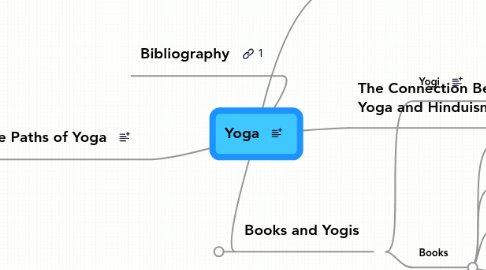
1. The Paths of Yoga
1.1. Karma-The Path of Selfless Action
1.1.1. Karma Yoga and Trensendence
1.1.2. What is Karma?
1.2. Raja-The Path of Meditation
1.2.1. Raja Meditation
1.2.1.1. The Obsticles of Meditation
1.2.2. States of Mind
1.2.3. The 8 Limbs
1.3. Jnana-The Path of Wisdom
1.3.1. Requirements to Fallow Jnana
1.3.2. The Principle
1.3.3. Levels of Enlightenment
1.3.3.1. Level One
1.3.3.2. Level Two
1.3.3.3. Level Three
1.3.4. Jnana Yogis
1.3.4.1. Problems That Can Arise
1.4. Hatha-The Path of Physical Purification
1.4.1. Creation by Shiva
1.4.2. Balancing Opposing Energies
1.4.3. Samadhi
1.4.4. Raja and Hatha
1.4.5. Asanas
1.4.6. Prana
1.4.6.1. Pranayama
1.4.7. Mudra
1.5. Bhakti-The Path of Love and Devotion
1.5.1. The Term Bhakti
1.5.2. The Development of Love
1.5.3. Types of Bhakti
1.5.3.1. Sakamya
1.5.3.2. Nishkamya
1.5.3.3. Para
1.5.4. The Enemy of Devotion
1.5.5. The Result of Bhakti
1.5.6. Bhavas
1.5.6.1. Types of Bhavas
1.5.6.1.1. Shanta
1.5.6.1.2. Dasya
1.5.6.1.3. Sakhya
1.5.6.1.4. Vatsalya
1.5.6.1.5. Madhurya
1.5.7. Cultivating Bhakti
2. Books and Yogis
2.1. Yogi
2.1.1. Famous Yogis
2.2. Books
2.2.1. Mahābhārata
2.2.2. The Savitri
2.2.3. The Bhagavad Gita
2.2.4. Sutras
2.2.5. Three Classic Texts of Hatha Yoga
2.2.5.1. Hatha Yoga Pradipika
2.2.5.2. Gheranda Samhita
2.2.5.3. Shiva Samhita
3. Bibliography
4. The Purpose of Yoga
4.1. Integrate the Body and Mind
4.2. Sankhya & Yoga
4.2.1. Balancing the Gunas- Liberation of the Soul
4.2.1.1. Types of Gunas
4.3. A Yoga Lifestyle
4.3.1. Asceticism
4.3.1.1. Samadhi
4.3.2. Yoga Principles
4.4. Fulfilling Darma
4.5. Physical Vs. Mental
5. The Connection Between Yoga and Hinduism
5.1. Complementary
5.2. Increasing One's Love for God
5.3. Yoga and the Philosophy of God
5.3.1. The Vedas
5.3.2. Continuity
5.3.3. Cosmic Evolution
5.3.4. Meditation
